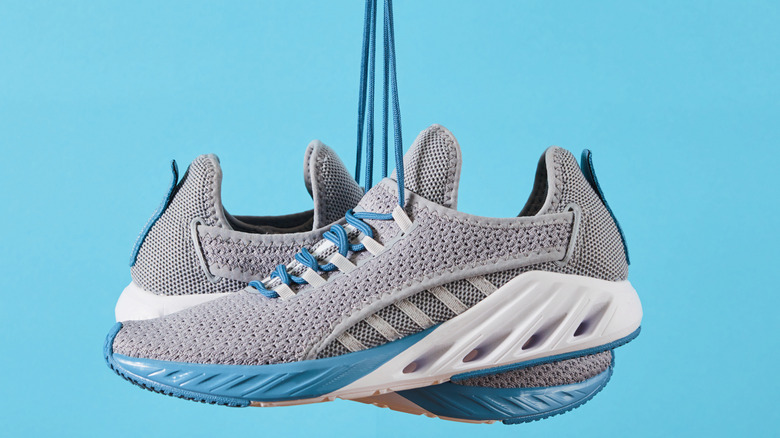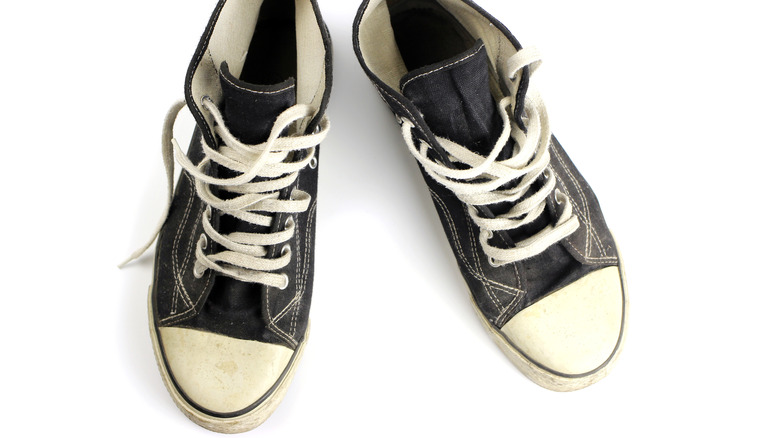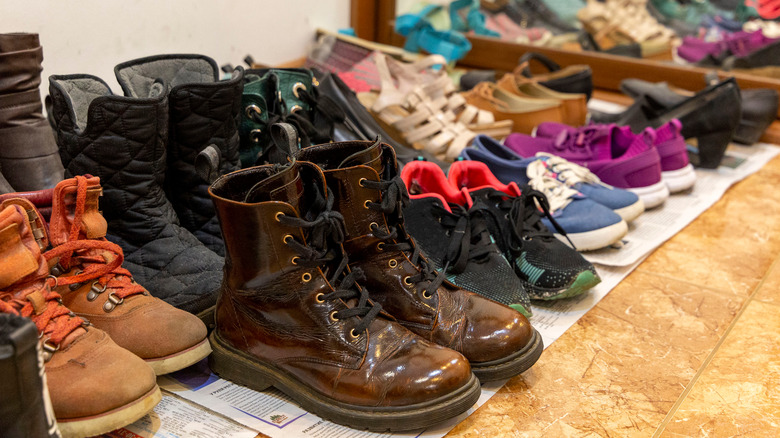Throw Your Shoes Away Immediately If You Notice This
We may receive a commission on purchases made from links.
Whether you're a shoe connoisseur with a vast collection, or a minimalist with a few essential pairs, a bit of care and proper storage can help you make the most of your footwear. Even pairs that see only occasional use can get worn out if they're just tossed in a closet.
When it comes to sneakers, "Don't stack them under your boots or other heavy shoes," Claire Wood, global performance manager for New Balance, told Runner's World. The lightweight, airy material that makes a great running shoe could get damaged. Wood also advises proper untying when you remove shoes. Otherwise, when you're in a hurry, you may be tempted to cram your feet in a tied pair. This bad habit can lead to shoes with damaged heel cups.
You can show your shoes some love by storing them any number of cubbies, clear containers, or ready-to-assemble furniture options (per MakeSpace). You can also make sure your out-of-season shoes are packed in acid free tissue and stored in a climate-controlled environment (per LifeStorage).
But shoes are meant to be worn. After all kinds of adventures and miles of strutting your style, even the most well-loved and well-kept pairs of shoes reach their end. So what signs indicate it's time to say good-bye?
Listen to your body—and follow your nose
Shoe lifespans vary, depending on how much they are worn. Sneakers should be used for running on average about 300-500 miles, according to Runner's World.
To determine if your shoes need replacing, put your shoes on an eye-level, flat surface. Podiatrist Dr. Jackie Sutera calls this the "tabletop test." If the shoes don't rest flat due to worn soles, they can cause pain or potential injury (per Footwear News).
Dr. Velimir Petkov, a podiatrist with Premier Podiatry, also suggests looking at the midsole, or cushioning part. Cracks or wrinkles in this area are a sign that the shoes can't provide as much comfort and support. Even if you don't spot any damage, pay attention to how you feel during and after you wear the shoe. Shoes that hurt your feet are a red flag that it's time for an upgrade.
Maybe the shoe is fine, but your foot changed. According to Dr. Joy Rowland, a podiatrist with the Cleveland Clinic, feet get longer and wider due to changes in ligaments and tendons. For pairs that you've had a long time, make sure they still fit. Avoid the damage of wearing too-small shoes.
While you're investigating, check your shoes for any funky smells. Many times these odors can be eliminated through the power of baking soda, a disinfecting spray, or a trip though the washing machine (per Good Housekeeping). If the odor can't be banished, say goodbye to the shoes (and the bacteria).
Toss responsibly and try to avoid the landfill
Before you toss shoes that no longer serve, explore some eco-friendly alternatives. Some brands offer a repair program that can restore your shoes to their former glory, like Chaco sandals' Rechaco. All kinds of parts, from straps and buckles to soles can be replaced. Prices start at $10 and increase from there, depending on the extent of the repairs.
For shoes that don't fit, but are in good shape, consider donating them to your favorite thrift shop or Goodwill.
Many manufacturers also offer their own recycling programs. Kamik rain boots made in North America are completely recyclable. Used pairs can be sent via a pre-paid shipping label. Teva offers a similar free-recycling program for their sandals, called TevaForever.
For athletic shoes, Nike will accept any brand. Worn pairs can be dropped off at Nike stores in the US and Europe, making this a convenient option if you have a bunch of old pairs. As part of the Nike Grind program, the recycled shoes see new life as playground, track, and turf surfaces.
For leather goods, consider upcycling. If you're feeling crafty, you could transform old boots and shoes into a pillow or an bespoke journal (per Inverse).


